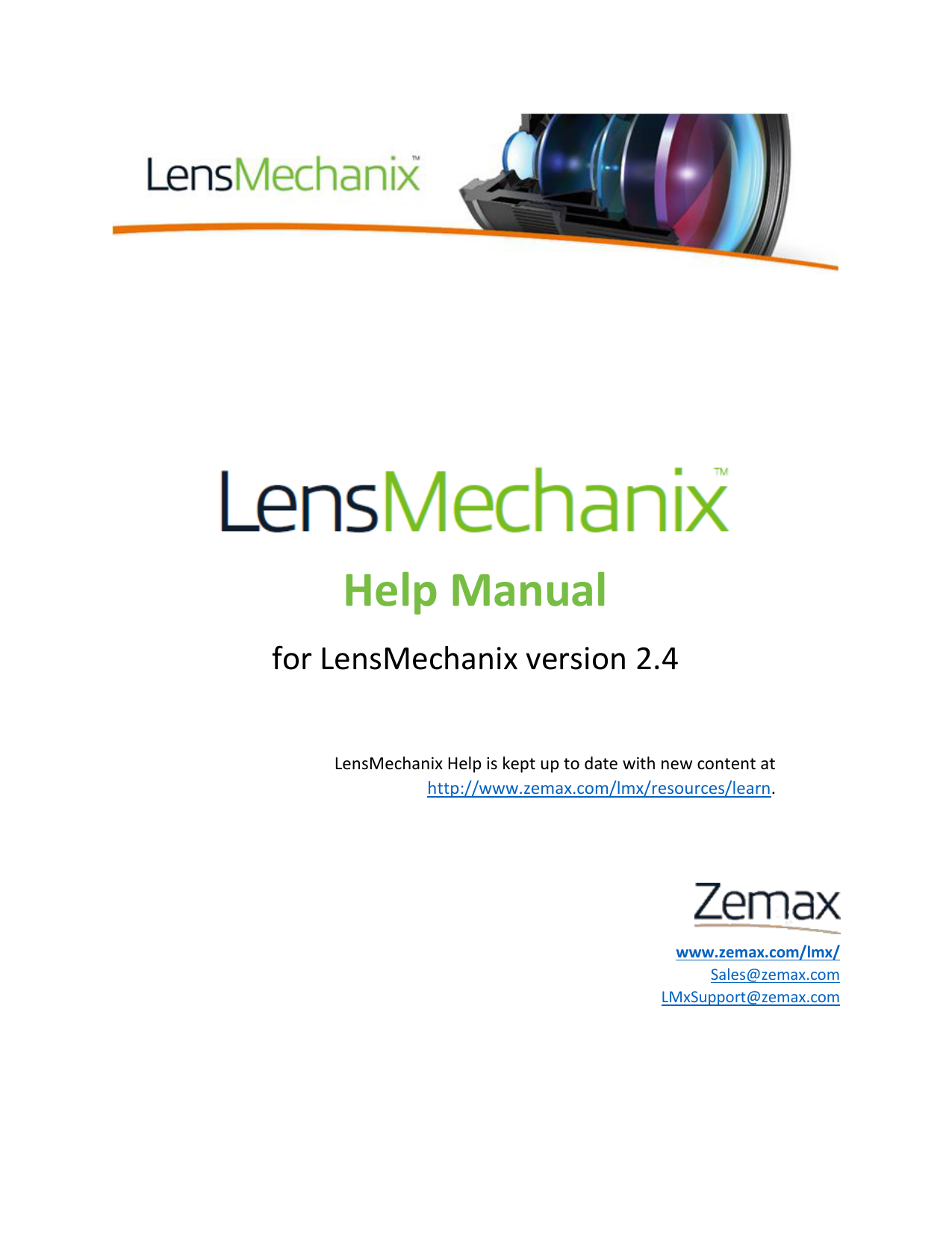Www Zemax
- 版权所有:光研科技南京有限公司 ICP备案号:苏ICP备14050759号 地址:中国江苏省南京市江宁区锦绣街5号绿地之窗C5座901室 销售咨询:sales@wavelab-sci.com.cn 技术支持:support@wavelab-sci.com.cn.
- Zemax is a company that sells optical design software. OpticStudio is its flagship product and a commonly used optical design program for Microsoft Windows. It is used for the design and analysis.
- Page 3 of 74 1 About This Guide Congratulations on your purchase of ZEMAX! ZEMAX is the industry standard optical system design software, combining sequential lens design, analysis, optimization.
OpticStudio is optical and illumination design software used to simulate virtually any system that interacts with light. It provides a complete suite of analyses to determine how a designed system performs. If performance needs to be improved, sophisticated optimization algorithms put the full power of your multi-core computer to the task. Before a design is ready to be fabricated, simulate the effects of fabrication and assembly errors using extensive tolerancing capabilities. Common applications include cameras, telescopes, microscopes, endoscopes, lasers, fiber couplers, heads-up displays, automobile headlights, street lights, and many others. Customers span the gamut of advanced technology industries including defense/aerospace, biomedical, automotive, consumer electronics, machine vision, and more.
Harness the power of Zemax optics software. By harnessing the power of OpticStudio®, OpticsBuilder™, and OpticsViewer™, optical, mechanical, and manufacturing engineers can speak the same language across the optical product development process. Can't find what you are looking for? Come join the community, ask questions and find answers to all Zemax software.
Customers work on such a wide array of applications that custom programming capabilities are a necessity. OpticStudio provides the ability to communicate with MATLAB or any other COM/.NET enabled program. Users typically drive OpticStudio from MATLAB using scripts or UI elements. The capability allows users to define/change optical systems, run any analysis and return data, optimize and tolerance. Nearly any task possible manually can be done through the COM/.NET interface. In addition, a simplified scripting language (ZPL) is supported for automating tasks inside OpticStudio.
Zemax is a company that sells optical design software.[1] OpticStudio is its flagship product and a commonly used optical designprogram for Microsoft Windows.[2][3][4][5] It is used for the design and analysis of both imaging and illumination systems.

History[edit]
OpticStudio, then called Zemax, was originally written by Ken Moore and was the first optical design program specifically written for Windows.[6][7] It became commercially available in 1990.[8] The first version was called Max, named after the programmer's dog. The name was later changed to Zemax due to a trademark conflict.[6] The software was rebranded as OpticStudio in 2016.[9]
The program was originally sold by Focus Software, which later became Zemax Development Corp.[10] The latter merged with Radiant Imaging in 2011 to form Radiant Zemax.[4] In 2014 Radiant sold Zemax to Arlington Capital Partners, which named the company Zemax, LLC.[11] Arlington Capital Partners sold Zemax to EQT June 26, 2018.[12]

Features and applications[edit]
OpticStudio is an optical design program that is used to design and analyze imaging systems such as camera lenses, as well as illumination systems. It works by ray tracing—modelling the propagation of rays through an optical system. It can model the effect of optical elements such as simple lenses, aspheric lenses, gradient-index lenses, mirrors, and diffractive optical elements, and can produce standard analysis diagrams such as spot diagrams and ray-fan plots.[10][13] OpticStudio can also model the effect of optical coatings on the surfaces of components.[10] It includes a library of stock commercial lenses.[14] OpticStudio can perform standard sequential ray tracing through optical elements, non-sequential ray tracing for analysis of stray light, and physical optics beam propagation. It also has tolerancing capability, to allow analysis of the effect of manufacturing defects and assembly errors.[15]
Www.zmaxauto.com
The physical optics propagation feature can be used for problems where diffraction is important, including the propagation of laser beams and the coupling of light into single-mode optical fibers.[16] OpticStudio's optimization tools can be used to improve an initial lens design by automatically adjusting parameters to maximize performance and reduce aberrations.[17]
References[edit]
- ^'Zemax company website'. Zemax. 8 August 2019.
- ^Fischer, Robert E.; Tadic-Galeb, Biljana; Yoder, Paul R. (2008). Optical System Design (2nd ed.). New York: McGraw-Hill. p. 603. ISBN0-07-147248-7.
...the Zemax software package, one of the industry's standards.
- ^Smith, Warren J. (2007). Modern Optical Engineering (4th ed.). McGraw-Hill. p. 436. ISBN0-07-147687-3.
- ^ ab'Radiant, Zemax merge with backing from Evergreen Pacific'. Bizjournal. Retrieved 21 July 2013.
- ^Geary, Joseph M. (2002). Introduction to Lens Design: With Practical Zemax Examples. Willmann-Bell. ISBN0-943396-75-1.
- ^ abMoore, Ken (21 April 2006). 'Why is it called ZEMAX?'. ZEMAX Users' Knowledge Base. Archived from the original on 12 May 2008. Retrieved 30 May 2008.
- ^McLean, Ian S. (2008). Electronic imaging in astronomy : detectors and instrumentation (2nd ed.). Berlin: Springer. p. 203. ISBN3540765824.
- ^'Design software: which package do you need?'. Opto & Laser Europe. July–August 2003. Retrieved 21 July 2013.
- ^'OpticStudio 16 manual'(PDF). Zemax customer website. 2016.
- ^ abcTesar, John (March 1997). 'Latest Zemax creates and evaluates designs'. Laser Focus World. 33 (3). Retrieved 2008-05-30.
- ^'About us'. Zemax.com. Retrieved September 10, 2015.
- ^'EQT press release'. EQT website. June 26, 2018.
- ^Laikin, Milton (2006). Lens Design (4th ed.). CRC. ISBN0-8493-8278-5.
- ^Fischer (2008), p. 590.
- ^'Tolerancing'. Radiant Zemax website. Retrieved 22 July 2013.
- ^'Exploring Physical Optics Propagation in Zemax'. Radiant Zemax website. Retrieved 22 July 2013.
- ^'Optical Optimization'. Radiant Zemax website. Retrieved 22 July 2013.
Www.zmaxdragway.com
External links[edit]
Zemax Opticstudio

